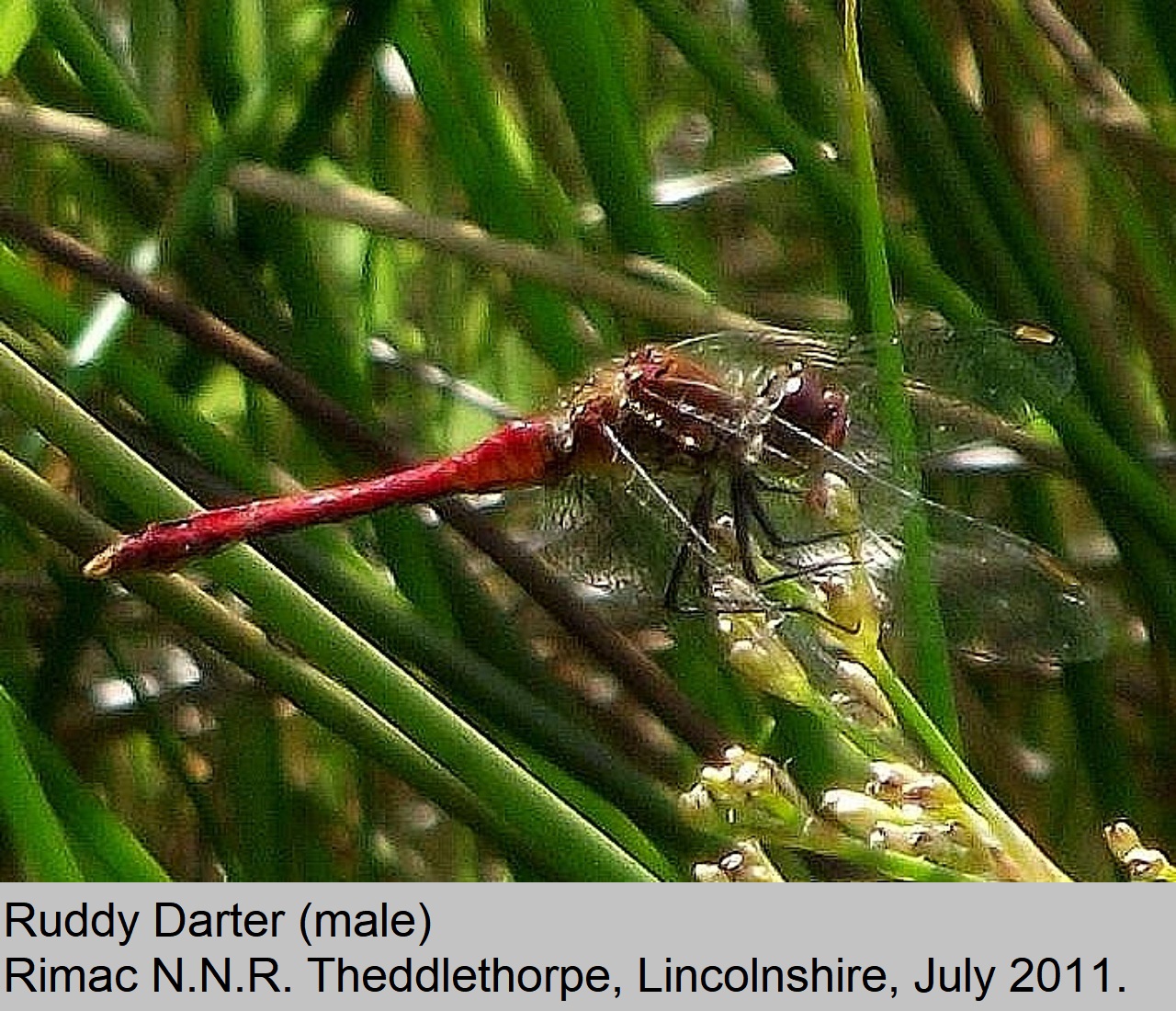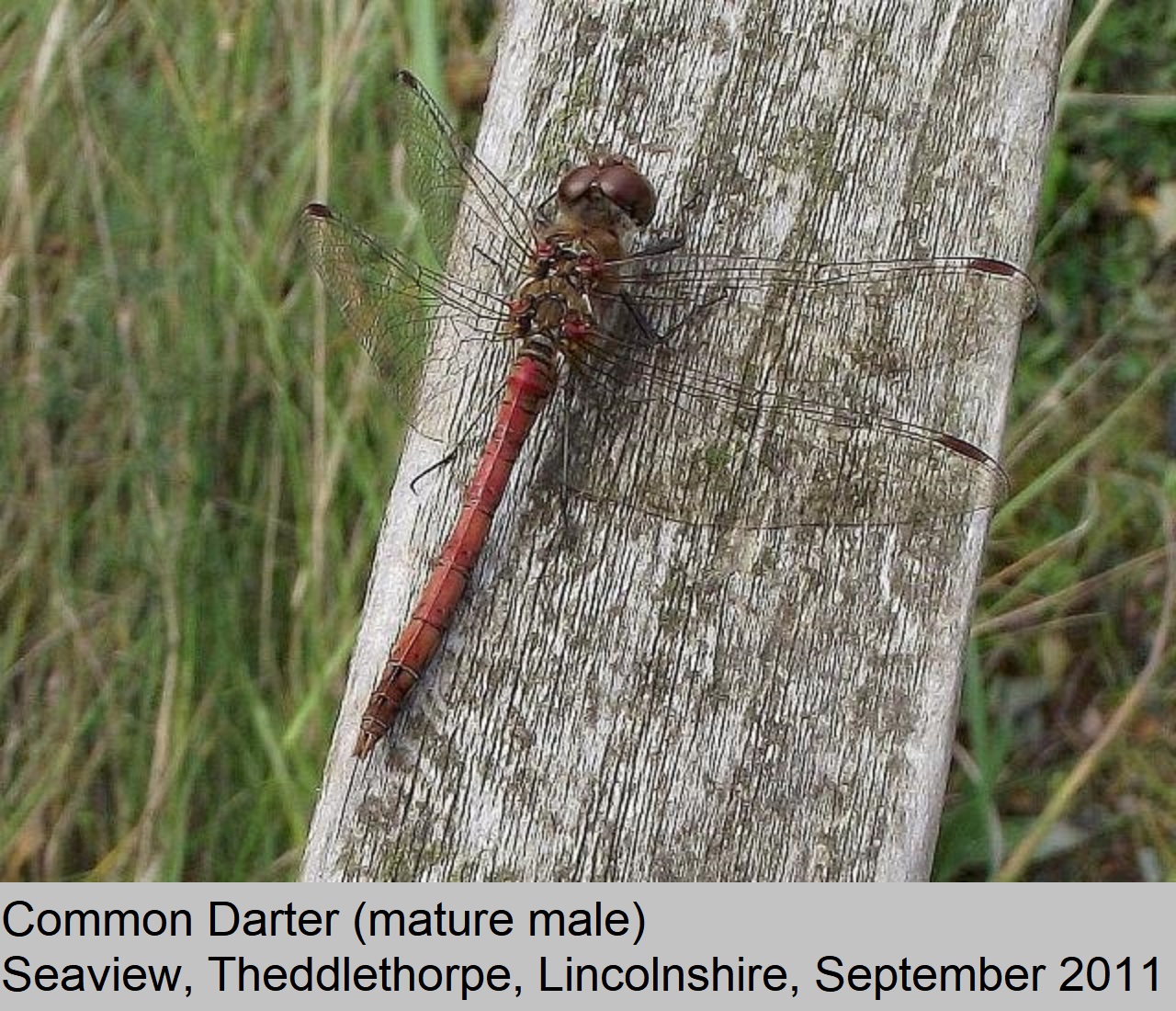|
|
||||||
|
|
|
|||||
| (Muller 1764) | (Muller 1764) | (Muller 1764) |
| Odonta - Anisoptera | Odonta - Anisoptera | Odonta - Anisoptera |
| Ruddy Darter - Sympetrum sangiuneum | Ruddy Darter - Sympetrum sangiuneum | Ruddy Darter - Sympetrum sangiuneum |
 |
||
| (Muller 1764) | (Charpentier 1840) | (Charpentier 1840) |
| Odonta - Anisoptera | Odonta - Anisoptera | Odonta - Anisoptera |
| Ruddy Darter - Sympetrum sangiuneum | Common Darter - Sympetrum striolatum | Common Darter - Sympetrum striolatum |
|
UK Status: Resident Distribution: This dragonfly is fairly common over most of England, and is expanding it's range into Wales. It's scarce in the south west of England, and has reached Scotland, where it is found in a few southerly sites. Body Length: 33mm to 37mm Wing Span: 41mm to 51mm Habitat: This species seems to prefer still, or sluggish waters that are well vegetated. Ponds, canals, slow streams and small lakes are all possible habitats. It is often seen on woodland rides. Flight Period: Late April or early May, throughout the summer and early autumn, possible as late as November. Larval Period: The larvae emerge as adults a year after the eggs were laid. Food Source: Most small insects and invertebrates. Similar Species: The Common and Red-veined Darters are quite similar. The Ruddy Darter has all black legs, and the Common Darter has pale stripes on it's legs. |
||
| (Charpentier 1840) | (Charpentier 1840) | (Charpentier 1840) |
| Odonta - Anisoptera | Odonta - Anisoptera | Odonta - Anisoptera |
| Common Darter - Sympetrum striolatum | Common Darter - Sympetrum striolatum | Common Darter - Sympetrum striolatum |
 |
||
| (Charpentier 1840) | (Charpentier 1840) | |
| Odonta - Anisoptera | Odonta - Anisoptera | |
| Common Darter - Sympetrum striolatum | Common Darter - Sympetrum striolatum | |
|
|
Status: UK Resident Distribution: This small dragonfly is abundantly common across the British Isles, with the exception of some upland areas in Scotland, and northern England. It is still expanding it's range, and seems to thriving in the present climate. Body Length: 37mm to 44mm Wing Span: 47mm to 55mm Habitat: Ponds, and other still waters are favoured, including stagnant pools. They wander well away from water, and are seen in woodland rides. Flight Period: Late April or early May, throughout the summer and early autumn, possible as late as November. Larval Period: The larvae emerge as adults a year after the eggs were laid. Food Source: Most small insects and invertebrates. Similar Species: The Ruddy and Red-veined Darters are quite similar. The Ruddy Darter has all black legs, and the Common Darter has pale stripes on it's legs. |
|
| (Linnaeus 1758) | (Linnaeus 1758) | |
| Odonta - Libellulidae | Odonta - Libellulidae | |
| Vagrant Darter - Sympetrum striolatum | Vagrant Darter - Sympetrum striolatum | |
|
|
Status: UK Rare vagrant, though becoming more frequent. Probably under recorded because of it's similarity to two other species. Distribution: South eastern England, as far north as Norfolk. Body Length: 35mm to 40mm Wing Span: 40mm to 50mm Habitat: Shallow ponds and other still standing bodies of water, with plenty of vegetation. Flight Period: Late May through into October. Larval Period: No data. Food Source: Most small insects and other invertebrates. Similar Species: The Ruddy and Red-veined Darters. |
|
|
Next True Bugs- Page 1 |
||
| Contact Website Manager dave.hatton29@btinternet.com | Web Designer Dave Hatton | Dave Hatton reserves the copyright on all images. © 2022 |